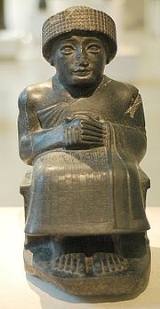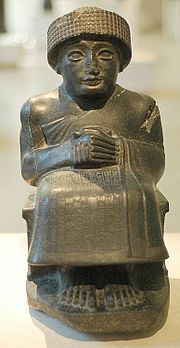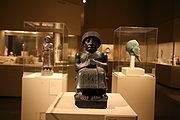
Statues of Gudea
Encyclopedia


Twenty-seven statues of Gudea have been found so far (A-AA). A-K were found during Ernest de Sarzec
Ernest de Sarzec
Ernest Choquin de Sarzec was a French archaeologist, to whom is attributed the discovery of the civilization of ancient Sumer. He was in the French diplomatic service; on being transferred to Basra in 1872 as a vice-consul, he became interested in the excavations at Ur, started by the British...
's excavations in the court of the palace of Adad-nadin-ahhe in Telloh (ancient Girsu). Statues M-Q come from clandestine excavations in Telloh in 1924; the rest come from the art trade, with unknown provenances and sometimes of doubtful authenticity
Authenticity in art
Authenticity in art has a variety of meanings related to different ways in which a work of art or an artistic performance may be considered authentic.Denis Dutton distinguishes between nominal authenticity and expressive authenticity....
. Figures L and R do not represent Gudea
Gudea
Gudea was a ruler of the state of Lagash in Southern Mesopotamia who ruled ca. 2144 - 2124 BC. He probably did not come from the city, but had married Ninalla, daughter of the ruler Urbaba of Lagash, thus gaining entrance to the royal house of Lagash...
with reasonable certainty. The statues were to represent the ruler in temples, to offer a constant prayer in his stead; offerings were made to these. Most of the statues bear an inscribed dedication explaining to which god it was dedicated. Gudea is either sitting or standing; in one case (N), he holds a water-jug au vase jaillissant. He normally wears a close fitting kaunakes
Kaunakes
The kaunakes, from Greek "thick cloak", was a woolen skirt or cloak woven in a tufted pattern suggesting overlapping petals or feathers, either by sewing tufts onto the garment or by weaving loops into the fabric...
, maybe made of sheep-skin, and a long tasseled dress. Only in one example (M, Soclet-statue) he wears a different dress, reminiscent of the Akkadian royal costume (torso of Manishtushu
Manishtushu
Manishtushu was a king of the Akkadian Empire from 2276 to 2261 BC. His name is also spelled as Maništušu.- Biography :Manishtushu was the son of Sargon of Akkad and Queen Tashlultum, brother of En-hedu-ana and the father of Naram-Sin...
). On the lap of one of them (statue B) is the plan of his palace, with the scale of measurement attached. Statue F is similar to statue B; both are missing their heads, and have on their lap a board with a measuring scale and a stylus, only statue F doesn't have a ground plan.
It seems that the early statues are small and made of more local stones (limestone
Limestone
Limestone is a sedimentary rock composed largely of the minerals calcite and aragonite, which are different crystal forms of calcium carbonate . Many limestones are composed from skeletal fragments of marine organisms such as coral or foraminifera....
, steatite and alabaster
Alabaster
Alabaster is a name applied to varieties of two distinct minerals, when used as a material: gypsum and calcite . The former is the alabaster of the present day; generally, the latter is the alabaster of the ancients...
); later, when wide-ranging trade-connections had been established, the more costly exotic diorite
Diorite
Diorite is a grey to dark grey intermediate intrusive igneous rock composed principally of plagioclase feldspar , biotite, hornblende, and/or pyroxene. It may contain small amounts of quartz, microcline and olivine. Zircon, apatite, sphene, magnetite, ilmenite and sulfides occur as accessory...
was used. Diorite had already been used by old Sumerian rulers (Statue of Entemena
Entemena
Entemena was a son of En-anna-tum I, and he reestablished Lagash as a power in Sumer. He defeated Illi of Umma, with the aid of Lugal-kinishe-dudu of Uruk, successor to Enshakushanna, who is in the king list.-Artifacts:...
). According to the inscriptions, the diorite (or gabbro
Gabbro
Gabbro refers to a large group of dark, coarse-grained, intrusive mafic igneous rocks chemically equivalent to basalt. The rocks are plutonic, formed when molten magma is trapped beneath the Earth's surface and cools into a crystalline mass....
, na4esi) came from Magan
Magan
Majan was an ancient region which was referred to in Sumerian cuneiform texts of around 2300 BC as a source of copper and diorite for Mesopotamia....
.
The dedication of the diorite statues normally tell how ensi
ENSI
ENSI is a Sumerian title designating the ruler or prince of a city state...
Gudea had diorite brought from the mountains of Magan, formed it as a statue of himself, called by name to honour god/goddess (x) and had the statue brought into the temple of (y). Most of the big (almost lifesize, D is even bigger than life) statues are dedicated to the top gods of Lagash
Lagash
Lagash is located northwest of the junction of the Euphrates and Tigris rivers and east of Uruk, about east of the modern town of Ash Shatrah. Lagash was one of the oldest cities of the Ancient Near East...
: Ningirsu, his wife Ba'u, the goddesses Gatumdu and Inanna
Inanna
Inanna, also spelled Inana is the Sumerian goddess of sexual love, fertility, and warfare....
and Ninhursanga as the "Mother of the gods". Q is dedicated to Ningiszida, Gudea's personal protective deity more properly connected to Fara and Abu Salabikh
Abu Salabikh
The low tells at Abu Salabikh, around 12 miles northwest of the site of ancient Nippur in Al-Qādisiyyah province, Iraq mark the site of a small Sumerian city of the mid third millennium BCE, with cultural connections to the cities of Kish, Mari and Ebla...
, the smaller M, N and O to his "wife" Gestinanna. The connection between Ningiszida and Gestinanna was probably invented by Gudea in order to effect a closer connection to Lagash.
| number | material Material Material is anything made of matter, constituted of one or more substances. Wood, cement, hydrogen, air and water are all examples of materials. Sometimes the term "material" is used more narrowly to refer to substances or components with certain physical properties that are used as inputs to... | size | posture | provenance | dedicated to | today at | museum catalogue number |
|---|---|---|---|---|---|---|---|
| A | diorite | 1,24 | standing | excavations E. de Sarzec, Telloh | Ninhursanga/Nintu | Louvre | AO 8 |
| B | diorite | 0,93 | sitting | excavations E. de Sarzec, Telloh | Ningirsu | Louvre | AO 2 |
| C | diorite | 1,38 | standing | excavations E. de Sarzec, Telloh | Inanna | Louvre | AO 5 |
| D | diorite | 1,57 | sitting | excavations E. de Sarzec, Telloh | Ningirsu | Louvre | AO 1 |
| E | diorite | 1,42 | standing | excavations E. de Sarzec, Telloh | Ba'u | Louvre | AO 6 |
| F | diorite | 0,86 | sitting | excavations E. de Sarzec, Telloh | Gatumdu | Louvre | AO 3 |
| G | diorite | 1,33 | standing | excavations E. de Sarzec, Telloh | Ningirsu | Louvre | AO 7 |
| H | diorite | 0,77 | sitting | excavations E. de Sarzec, Telloh | Ba'u | Louvre | AO 4 |
| I | diorite | 0,45 | sitting | excavations E. de Sarzec, Telloh | Ningishzida | Louvre | AO 3293 + AO 4108 |
| J | diorite | -- | -- | excavations E. de Sarzec, Telloh | -- | -- | -- |
| K | diorite | 1,24 | standing | excavations E. de Sarzec, Telloh | Ningirsu | -- | -- |
| L | diorite | -- | -- | -- | -- | (Kudurru) | -- |
| M | alabaster or paragonite | 0,41 | standing | clandestine excavations, Telloh 1924 | Geshtinanna | Detroit Institute of Arts | -- |
| N | dolerite, calcite or steatite | 0,61 | standing | clandestine excavations, Telloh 1924 | Geshtinanna | Louvre | AO 22126 |
| O | steatite | 0,63 | standing | clandestine excavations, Telloh 1924 | Geshtinanna | Ny Carlsberg Glyptotek, Copenhagen | NCG 840 |
| P | diorite | 0,44 | sitting | clandestine excavations, Telloh 1924 | Ningishzida | New York, Metropolitan Museum of Art | 59.2 |
| Q | diorite | 0,33 | sitting | clandestine excavations, Telloh 1924 | Ningishzida | body in Baghdad, head in Philadelphia | body: 2909, head: CBS 16664 |
| R | diorite | 0,185 | sitting | art trade | Namhani | Harvard Semitic Museum | HSM 8825 |
| S | limestone | -- | standing | -- | -- | Louvre | -- |
| T | -- | 1,24 | -- | -- | -- | Golenishev collection | -- |
| U | dolerite | 1,01 | standing | -- | Ninhursanga/Nintu | British Museum | -- |
| V | diorite | 0,74 | standing | -- | -- | British Museum | -- |
| W | diorite | -- | -- | -- | -- | -- | -- |
| X | diorite | -- | -- | -- | Meslamta'ea | -- | -- |
| Y | limestone | -- | -- | -- | Ningirsu | -- | -- |
| Z | diorite | -- | -- | -- | -- | -- | -- |
| AA | limestone | -- | -- | -- | -- | -- | -- |
Further reading
- Dietz Otto Edzard, "Gudea and His Dynasty" Royal Inscriptions of Mesopotamia Early Periods - RIME 3/1 (Toronto University Press 1997).
- F. Johansen, "Statues of Gudea, ancient and modern". Mesopotamia 6, 1978.
- A. Parrot, Tello, vingt campagnes des fouilles (1877-1933). (Paris 1948).
- H. Steible, "Versuch einer Chronologie der Statuen des Gudea von Lagas". Mitteilungen der Deutschen Orient-Gesellschaft 126 (1994), 81-104.
External links
- Photographs of the Gudea statues at Louvre Insecula.com
- Seated Statue of Gudea at arthistorylessons.net
- Statue M The Detroit Institute of Arts

